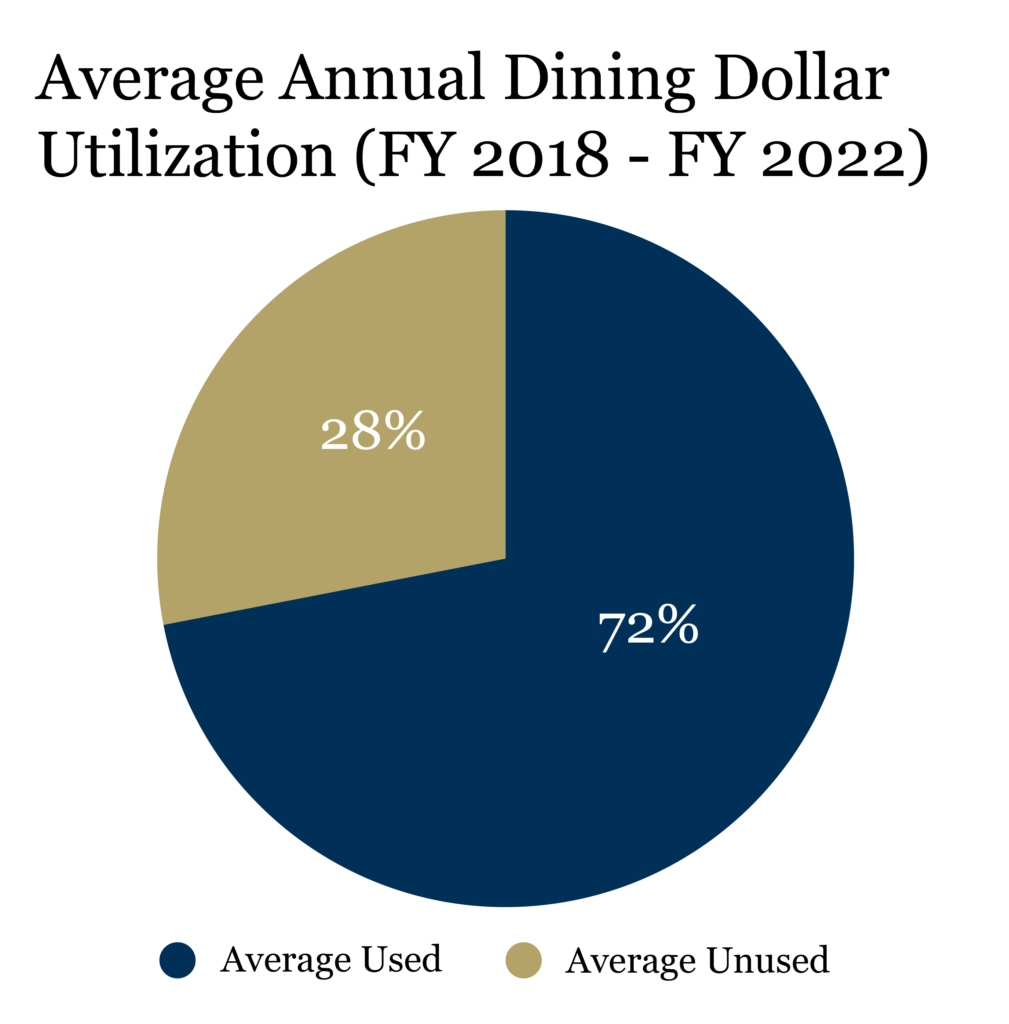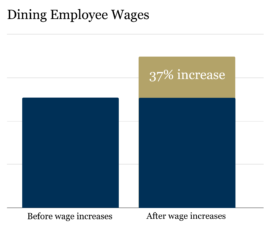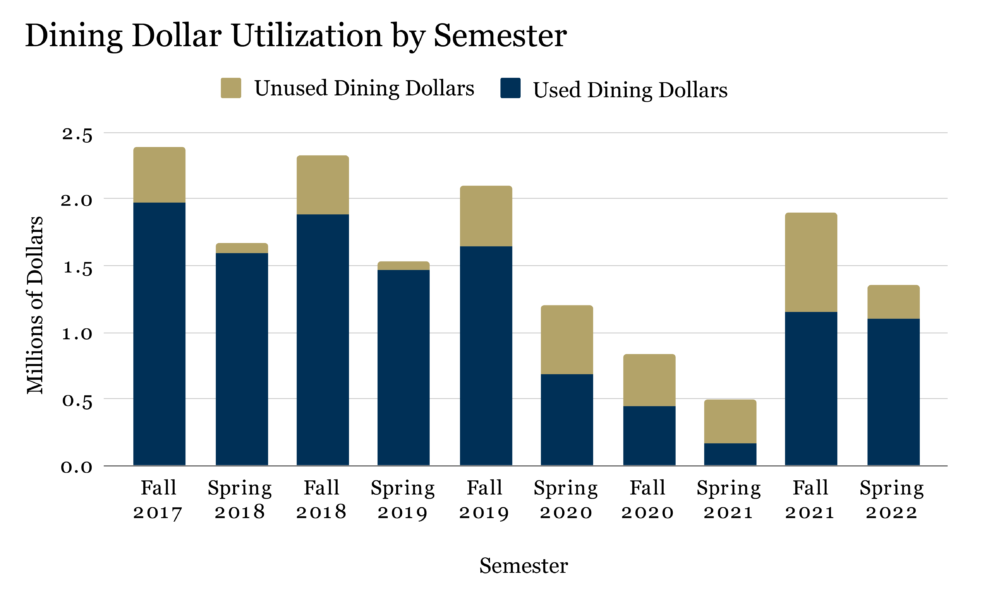At the end of every semester, Georgia Tech students scramble to use up their meal swipes and dining dollars. While both meal swipes and dining dollars now roll over from Fall to Spring, the end of the Spring semester often spurs spending sprees on students as they rush to utilize their funds before they expire.
Rising third year student Gehrig Harris (BA ‘24) described his situation prior to the close of the Spring 2022 semester.
“I noticed I had, like, 400 [dining dollars] left, so I hurried and used a bunch… I bought stuff for a class meeting voluntarily, and I bought protein shakes every day,” said Harris in a Zoom meeting. “I think I ended the year with about 398 dining dollars left, approximately.” Harris had selected the unlimited everyday plan, which came with 450 dining dollars for the semester.
Meal swipes can be used at any of the Institute’s three dining halls: North Avenue, Brittain, and West Village. Dining Dollars, on the other hand, are more flexible. They may be used at dining halls, food trucks, various retail dining locations across campus, and at some restaurants in Tech Square.
“I actually didn’t even realize I could use them at the gym until the last three or four weeks of school,” said Harris.
Some students, anticipating this end of year frenzy, elected for a planned approach to dining at Tech.
Rising fourth year Gabriel Armstrong (CS ‘23) described in detail his plan for the semester over GroupMe, a popular chat application used by Tech students. “I started each semester with 50 Meal Swipes. Toward the end of fall semester, I got 600 regular + 60 bonus dining dollars. I would go to lunch and pay the $12.50 rate with dining dollars. When Spring started, I did the same thing, switching to dining dollars when I ran out of swipes.”
Armstrong wrote that using dining dollars for dinner was not feasible, citing the high door cost at the dining halls. “Specifically for the Spring, I used up most swipes (lunch and dinner) and then started using dining dollars for lunch, and my few remaining swipes for those times I would go to dinner.”
Armstrong described his experiences with meal plans as difficult to use entirely. “It’s hard because you can only purchase swipes in increments of 50: I find that 50 is too few and a 100 … is too many.”
He went on to describe his friends’ experiences with purchasing meal swipes. “… everything except the 50 Meal Pass plan comes with dining dollars. I think they do that because having dining dollars sounds nice, but many students I see just don’t really use them. As such, many of my friends end up with plenty of extra dining dollars at the end of the year.”
Armstrong’s friends weren’t alone— a GroupMe group chat was formed, called the Dining Dollars Free Food Group. The group’s description reads “We burn through your dining dollars and meal swipes or GT takes it all back. And you get to meet new friends.”

Rising second year Freddie Wright (Biology ‘25) is a member of this group chat, which was formed on Mar 29, 2022. Wright purchased the 250 dining dollar plan, along with the unlimited every day plan. “For spring semester, I had run out at the start of April,” wrote Wright in a GroupMe message.
Wright explained that he was “completely out” by April. “I was one of the scavengers using other people’s dining dollars.”
When he did have dining dollars, he elected to spend his money on retail dining options on campus. “I got food at Panda Express and Rising Roll the majority of the time.”
Long wait times for food dissuaded Wright from buying food from the food trucks. “They were nice, but the lines were so long that I usually just went hungry and studied.” Wright said he also frequented the West Village dining hall, but didn’t find the food appealing. “Also, from where I studied, the food trucks and other dining dollar places were a lot closer and on my way to class.”
Students speculate that Tech Dining purposely makes it difficult for students to use all the funds they’ve paid for. “Tech does not make it easy to spend them all,” said Armstrong.
Tech Dining Director, Ryan Greene, said over a Teams call that the goal of Tech Dining is not to reduce utilization rates, but rather the opposite. “The goal of any good dining program is not to try to keep it low to save money because ultimately, if people are using the meal plan, they’re going to keep buying the meal plan, and the more people that participate in the meal plan, the larger the program gets.”
Dining Dollars and Meal Swipe purchases are just one part of the financial picture for Tech Dining. Other streams of revenue are faculty/staff dining dollars, catering operations, and credit/debit card purchases. “The biggest expenses of the program are personnel… and there was also a large increase in food costs,” Greene said.
Institute-wide and state-wide minimum wage increases for state employees resulted in an average 37% increase in dining staff wages over the last year. However, this money did not come from tax dollars, like it did for other state employees.

“For auxiliary, we have to fund that. We don’t get any money from the state because we’re an auxiliary program,” said Greene.
The new meal swipe roll over policy and overall supply chain issues caused by the COVID-19 pandemic led to an increase in food costs. In addition, Greene said the quality of food has improved compared to the contracted services provided by Aramark from (2019 to 2021) and Sodexo (from 1999 to 2019). “We’ve really doubled the plate cost in our dining halls, considering the number of offerings and the quality of food in terms of the products we’re ordering.”
Greene said any revenue earned from the underutilization of dining dollars simply flows back to the bottom line. “If you look at the entire portfolio of the expenses of the dining program and you simply look at what’s not utilized by dining dollars and meal plan swipes, it’s really a small portion of it. It’s just going back into paying our people more money and providing higher quality and more expensive products in the dining halls and in our retail concepts.”
